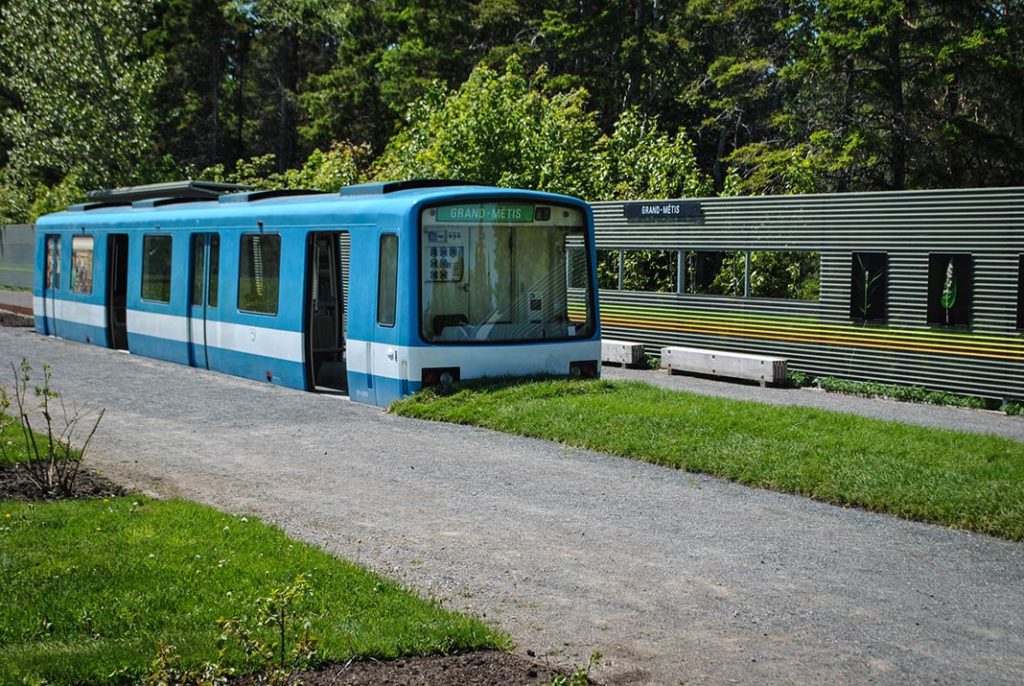
To highlight the 375th anniversary of Montreal, Les Jardins de Métis/Reford Gardens has transported one of the iconic MR-63 métro wagons to their Linear Garden – to create the first ever Grand-Métis Station. With the original métro wagons built for Expo 67 making way for the new AZUR trains, the Société de Transport de Montréal (STM) launched a call for proposals in the spring of 2016 to give them a second life.

One of just seven projects chosen by the STM is this one, imagined by Le Bocal, a creative laboratory from ABCP architecture in Quebec City. It consists of installing an MR-63 in the Linear Garden whose configuration and dimensions curiously recall those of the métro stations in Montreal.

This unusual landscape and experiential installation decontextualizes an MR-63 from its underground reality and gives it a new home in the Gaspé landscape. You are now able to wander through an MR-63 engine car that has been retired to the pastoral landscape of the Gardens. Liberated from the darkness of the tunnels of Montreal from which it has emerged, users will discover a luminous interior with views on the rich vegetation, a décor that is a surreal visual and soundscape, a marked contrast with the underground universe of the métro. Grand-Métis Station is the easternmost terminus of the Montreal métro, a well-deserved resting place for this MR-63, the station where the many miles and underground dreams finally end by coming into the light of day!

This project integrates architecture and landscape. It provides a link between Elsie Reford, the creator of the gardens, whose life was divided between Montreal during the winter months and Estevan Lodge in Grand-Métis in the summers. The year 2017 marks the 50th anniversary of her death at her home on Drummond Street in Montreal and the 110th anniversary of the Canadian Women's Club of Montreal, co-founded with Julia Drummond. Montrealers are invited to spend a summer vacation at the river's edge, to discover the magnificent gardens she has built since 1926.

The métro has always been a good partner of artists. The Grand-Métis Station is no exception. Discover twelve works by artist Fernande Forest. Her exhibition Curiosités forestières (Curiosities of the Forest) – a reference to the cabinet of curiosities of the Renaissance - presents a series of artistically modified organisms (AMOs). From specimens of plants picked and photographed, Forest has modified botany by manipulating plants using photomontage. She blends and combines flowers, seeds, leaves and stems to create new species that seem real, but which push reality to its limits. These images offer a personal look at the photography of the plant world. These simple wildflowers are both magnified and made poetic. In addition to sparking interest, surprise and curiosity, the AMOs (like GMOs), question the impact of humans on nature and underline the importance of preserving biodiversity. The artist, creator and mythmaker, can create plants unusual, intriguing and even fantastic, but what happens when science and industry act in this way?

Originally from Bonaventure in the Gaspé Peninsula, Fernande Forest lives and works in Rimouski where she has been actively involved in the visual arts for more than 30 years. Nature and the human condition are at the heart of her approach. Her research creates a dialogue between the living and the virtual, generating a poetic reading of our reality and exploration the relations between the real and the medium of photography.

Her works have been exhibited in Canada and Europe. She has participated in several in situ symposia, most recently in 2015, at the Rencontres photographiques du Kamouraska; in relational art with elderly people: The Troubadour Wall in France in 2012-2013; with children: Me at work, from 2014 to 2016 at the Centre d’art de Kamouraska; and Souvenance - Portraits of Acadians of Today, at the centre d’artistes Vaste et Vague in Carleton-sur-Mer, 2017. She has been commissioned to do several public art projects for the Politique d’intégration des arts à l’architecture et à l’environnement (1%), including the one in the dining room of Estevan Lodge.

A métro station is not complete or alive without the presence of musicians. Les Jardins de Métis have teamed up with the students of the Conservatoire de musique de Rimouski to provide occasional musical performances. Unlike the musicians of the métro, those from the Conservatoire will receive a wage for their performances; whatever money earned from visitors will be given to the student association of the Conservatoire. Les Jardins de Métis is also launching an invitation to musicians of all kinds to play and submit their application to festival@jardinsdemetis.com.
The Grand-Métis Station project is made possible thanks to the financial support of the Conseil des arts et des lettres du Québec and the contributions of close collaborators and sponsors including ABCP architecture, Tetra Tech, SOPREMA and many others.
• 375th anniversary of Montreal
• 150th anniversary of Canadian Confederation
• 130th anniversary of Estevan Lodge
• 110th anniversary of the Canadian Women's Club of Montreal
• 50th anniversary of Expo 67
• 50th anniversary of STM MR-63 wagons
• 50th anniversary of the death of Elsie Reford
• 30th anniversary of ABCP architecture
comments